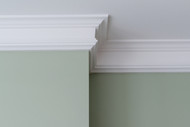Is Silicone Sealant A Good Moulding Adhesive?
Apr 18th 2024
Whether you’re remodeling a single room or working on a large project, you will likely be installing moulding at one point or another. Whether it’s crown moulding around a ceiling, trim, or baseboards, these decorative pieces enhance the look and feel of any home or interior.
Once all the required pieces of moulding have been purchased, measured, and then cut down to size, it’s time to attach them to the walls using an adhesive. This brings up an important question. Which compound is the best molding adhesive? Many professionals rely on silicone, but is it really a great option?
Find the answers to these questions and more in this article. Without further ado, let’s get started.
What Makes A Good Moulding Adhesive?
The best adhesives for moulding are going to have a number of key characteristics. These include:
- A strong bond
- Flexibility
- Moisture resistance
- Temperature resistance
- Ease of use
- Material compatibility
- Non-toxic
- Fast cure time
- Longevity
A strong bond is essential because nobody wants to trim falling off their walls. Flexibility and temperature resistance are tied directly to longevity. Over time, temperature changes cause different materials to expand and contract.
Adhesives that are too rigid will crack and fail. However, flexible, temperature-resistant glues and bonds will last the test of time.
Non-toxic is another key characteristic because these adhesives will be used for interior purposes. Using non-toxic compounds is essential for ensuring the safety of anyone using the space. A fast cure time is also great to have.
In many cases, you’ll have moulding attached to a high-up or suspended area. In these cases, you will need to have masking tape or some other way to keep the trim in place until the adhesive cures. A fast cure time makes this less of a problem.
Why Is Silicone An Excellent Choice As A Moulding Adhesive?
Silicone is most commonly referred to as a “sealant” because it is the main use and purpose of silicone in construction. However, silicone can and is often used as a construction adhesive for fixing objects in place, such as with moulding. This is because silicone creates a uniquely strong bond that can keep moulding in place nearly indefinitely. Silicone is also highly durable and versatile, adhering to many different materials, making it well-suited for attaching different types of moulding.
Silicone also exhibits a high degree of moisture resistance. Although weathering is obviously less of a concern for interior applications, kitchens and bathrooms can be impacted by high amounts of moisture exposure. Silicone does not warp or deteriorate but is highly water-resistant.
How To Use Silicone As A Crown Molding Adhesive
Installing moulding of any kind is simple to do. In many cases, trim is installed using either a nail gun or with brackets. Then, further adhesion and strength are provided using some form of glue or silicone.
First, cut the moulding to the preferred size. Then, if you are using brackets, attach them to the places on the wall where you will be installing the molding. Next, you’ll want to flip the moulding over and apply a small bead of silicone along the edges and inside the center.
At this point, you’re ready to attach the moulding to the wall. Carefully but firmly press the moulding against the wall and into place. In order to keep the moulding from being moved out of place while the silicone is curing, use a few pieces of masking tape around the trim. Usually, you’ll only need to wait 15 minutes to an hour before removing the masking tape.
Key Considerations To Be Aware of With Silicone
There are a few key things to remember when choosing a silicone sealant to glue trim pieces. Firstly, variety of material. Traditional silicone sealant works well with a wide range of materials, including:
- Metal
- Glass
- Marble
- Drywall
- Tile
- Ceramic
- Porcelain
- Painted Surfaces
- Non-Oily Woods
- Rubber
However, it is not uncommon for homes to use vinyl moulding for their trim. If you need a PVC molding adhesive, we recommend using a Neutral Cure Silicone Sealant. Other methods, like primers, may be helpful to ensure a strong, durable bond.
Another important consideration is paintability. Most silicone sealants do not create paintable surfaces. Consequently, if you are using the silicone in any visible place, it’s important to choose a color that fits in with your project. The best silicone providers offer a number of different colors to suit your needs.
Need To Get A Moulding Job Done? Use Silicone Depot!
Whatever kind of silicone adhesive you need, Silicone Depot has you covered. Our professional-grade, industry-standard silicone products are designed to last. Check out our product line here!

